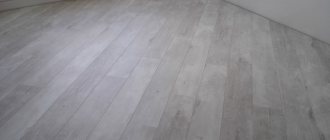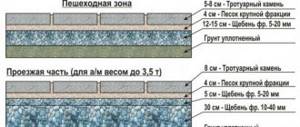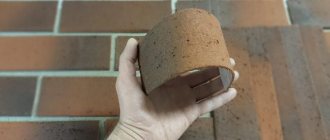Advantages of laying diagonally
Laying tiles diagonally has a number of advantages over conventional laying:
- Narrow cuts near the wall when laid diagonally are less noticeable and look more natural than when laid conventionally.
- When laying tiles in two adjacent rooms, you can clearly delimit them along the door line if in one of them the laying is done diagonally, and in the other - in straight rows.
- Laying floor tiles diagonally will help visually correct the incorrect geometry of the room and hide visible defects and unevenness.
- When laying tiles diagonally on the floor towards the natural light in the room, they will become noticeably lighter and take on a more elongated shape.
- If you lay rectangular tiles with the long side relatively narrow, the space of the room will visually expand.
Laying tiles diagonally has its advantages and disadvantages
Laying tiles diagonally, along with advantages, also has some disadvantages: this process is more difficult than laying in the usual way. At the same time, the consumption of materials is 5-10% higher due to the need to lay threaded parts to maintain the diagonal, which, in turn, causes a greater waste of time than when laying in the usual way.
Methods and methods
- Standard approach. Here you need to proceed from the laying pattern and geometry of the room, the tiles are placed in several ways:
- Start marking from the most visible corner of the room. This is the most suitable method for rectangular rooms. The first tile is placed in the corner, then two more tiles are laid in different directions from it. The final quality of the flooring depends on how smoothly the first three tiles are laid. This method is called “angular” and can be performed independently, as it does not require special training or skills.
- Styling from . Requires very careful and accurate calculations. The center of the room where the first tile is laid is calculated, and subsequent tiles are laid out in different directions.
- Layer by layer. The center of the room where the first tile is laid is also calculated. Then a vertical line is drawn from the middle of this tile, and subsequent ones are placed relative to it to the left and right, row by row. The rows are obtained in such a way that each subsequent row is shifted relative to the previous one by half a tile.
- In two perpendicular rows. This method is very suitable for rooms with irregular geometry, i.e. where there are various projections, bay windows, etc. The first tile is laid in the center of the room. Then two central perpendicular lines are drawn from it, and subsequent tiles are laid out along them in a line to the wall. The remaining tiles are laid out in the center relative to the formed rows.
- Laying tiles diagonally. To start work, you need to draw diagonal lines connecting the opposite corners of the room. This can be done by rubbing chalk on any cord or rope. But this can be done better and more accurately using a laser level. Based on this marking, you begin laying tiles from the center. The pattern of the tile covering does not matter at all.
- Unusual design methods. If you have some unusual, non-standard room design in mind, then it is better to first use graph paper and apply precise floor markings and tile placement onto it. The conceived design or pattern is transferred to paper, and the exact number of solid and cut tiles is calculated. And only after that they begin real work.
Tile laying schemes
Laying tiles on the floor diagonally can be done in the following ways:
- According to the completed markings, starting from the center of the room, solid plates are laid, and after that trimmings are laid out near the walls. Each corner of the room is used to determine the central reference point in the room. The point of intersection of the lines drawn from the corners will serve as a guideline for installation. This tile laying scheme is usually used in bathrooms and toilets, and small rooms. If the shape of the room is not square, but elongated, then the markings are made parallel to the wall.
Methods for laying tiles diagonally - Following the second method, the tiles must be laid starting from the corner of the room. To do this, it is cut diagonally into triangles and laid out sequentially in rows. When using this technology, there is a high probability of error, which may arise due to uneven walls, their non-perpendicular location, incorrect calculation, as a result of which the tiles may come apart at the laying stage.
Calculation of the required number of tiles
When choosing a facing material, it is recommended to very carefully compare the sizes of tiles, especially from different packs. If there is a discrepancy in length or width of even one or two millimeters, the masonry will turn out sloppy. All its decorative advantages will simply disappear! So you should use tiles of the highest possible grade, with the most accurate calibration.
All purchased packs of ceramic tiles must be of the same caliber. As you can see from what is shown in the illustration, the discrepancies in sizes can be very significant.
In this case, of course, the tiles should be intended exclusively for covering the floor. This will be indicated by the pictogram on the packaging with a footprint. No matter how much the buyer likes the appearance (and perhaps the price) of a model designed for wall covering, such a coating will not “live” for long on the floor. In addition, tiles are usually used for cladding in rooms where water can get on the floor. That is, the tile must also have anti-slip qualities. Just for personal safety reasons.
The boot icon on the inclined plane indicates the anti-slip properties of the cladding. And the footprint indicates that the ceramic tiles are intended specifically for the floor.
Before purchasing facing material, you should decide on its quantity. To do this, of course, you should clarify the dimensional parameters of the selected tile.
After this, it would be wise to draw up a drawing of the floor of the room in which the installation will take place. In this case, it is necessary to take into account everything - protrusions, niches, the location of heating radiators, communication risers, fixed pieces of furniture or large plumbing equipment (bathtub, shower stall, etc.) Careful execution of the drawing is especially important if you plan to create complex patterns with tiles on the floor different types.
The drawing must be made exactly to scale. For example, it could be 1:10.
A drawing of the room made to scale and a laying diagram applied to it will greatly simplify both the calculation of the required amount of material and the carrying out of facing work.
Tile calculations are done in several ways:
- If you do not intend to decorate the surface with a complex pattern, then calculating the number of tiles is not so difficult. To do this, you simply need to divide the total area of the room by the area of one tile.
- If you plan to lay out a panel on the floor, then the diagram should be more detailed, with the exact dimensions of each of its elements. This graphical calculation allows you to determine the number of tiles of different colors and sizes.
When determining the number of tiles, focusing on the drawn up diagram, you must consider the following:
- Two tiles cut in less than half must be counted as one.
- If a large part of a tile is cut off, it is also counted as one.
An example of drawing up a diagram of the distribution of tiles on the floor surface.
To the result obtained as a result of calculations, it is necessary to add 15÷20% of the total amount of material. This is a reserve for the remaining unavoidable trimmings, in cases of unsuccessful cutting that was not detected when purchasing defects or accidental independent damage to the tiles during the stages of its transportation and execution of work.
If the calculation is carried out for one type of tile, the reader can use the calculator offered below.
Calculator for calculating the required amount of ceramic floor tiles
The program is simple - it compares the area of the room for cladding with the dimensions of one ceramic tile. True, there will be some nuances.
- First of all, it is necessary to determine the area on which the ceramic cladding will be laid. There are usually no problems with rectangular rooms. Difficulties arise if the floor has a more intricate configuration. But even here you can be smart, break it into several sections of simpler shapes, calculate their areas and sum them up.
The area value is indicated in the first data entry field.
Calculation of area - to help in difficult cases.
Geometric formulas memorized in school may be forgotten. It's okay, we will help. A special publication on our portal is dedicated specifically to calculating the area of premises , with an analysis of complex cases and with built-in convenient online calculators.
Next, enter the length and width of the selected tile model in the appropriate fields. Since most manufacturers indicate the size in centimeters, the same unit of measurement is left in the calculator.
Don't forget about the thickness of the tile joint. When laid on the floor, it can be quite solid, and on large areas this parameter makes quite significant adjustments to the calculation result. The thickness of the seam is indicated in millimeters.
Finally, you should choose how to lay the tiles. It directly affects the size of the stock laid down when purchasing material. If for straight laying 10% is enough, then for diagonal laying it is better to reserve the entire 20%.
The result will be shown in unit terms - the number of tiles.
Go to calculations
It is better not to neglect the stock - there is no guarantee that if there is a shortage of tiles for one reason or another and you go to the store, this model with the same batch and caliber will be available. By the way, when purchasing material, you should try to immediately agree with the seller on two services. Firstly, this is the exchange of defects identified during work for high-quality products. And secondly, the return of unused material (naturally, we are talking about whole, uncut and undamaged tiles). Many showrooms, valuing their reputation, are willing to cooperate in such matters.
Tile laying process
The sequence of laying tiles diagonally under the initial stage involves preparing the floor surface - thorough cleaning and leveling. The floor surface should not contain any traces of the old coating, if any. The floor surface is primed to create better adhesion; an additional layer of waterproofing is applied in the bathroom and toilet, hallway and kitchen.
Next, the laying of floor tiles is marked. Experts recommend abandoning laying tiles away from the wall or from a corner in favor of marking in the center (in a square room) or in favor of marking, which consists of constructing an isosceles triangle. To do this, from two corners adjacent to one wall, segments of the same length are applied, the intersection of which becomes a point - a guideline for the first plate in the layout. For marking, a cord is used, stretched over the surface of the tile, which should orient its layout in height.
You can make the adhesive tile solution yourself from the necessary ingredients, or use a ready-made one, adding to it the required amount of water, in accordance with the instructions, and stir thoroughly. The adhesive is applied using a notched trowel to the floor surface and to the grooved side of the tile.
The tiles should be laid out strictly following the cord markings. Each laid row of tiles should be tapped with a rubber or wooden hammer until excess adhesive appears in order to ensure that there are no voids. At the same time, each diagonal row is checked with a level; there should be no gaps between it and the surface of the tile.
With respect to the vertical plane, it is also necessary to adjust the correct position of the tiles using a wide strip: it should make an angle of 45 degrees relative to the wall. Control of the horizontal arrangement of the rows is carried out using a special square with an angle of 90 degrees, which measures the intersection of the seams of the tiles; it should be a right angle. In areas adjacent to walls, cutting tiles at home is carried out using a tile cutter or grinder. The corners are filled with cuts 1-2 days after the main tile layer is laid, this is the time required for the glue to completely harden.
The final stage of laying tiles diagonally is grouting the joints. It is carried out using a rubber spatula on an area of 1.5 - 2 sq.m., after which the excess is removed from the surface of the tile, preventing it from drying out.
Carrying out independent laying of tiles in a diagonal pattern
Preparing the base
You should not assume that by purchasing an expensive version of floor tiles, it will be possible to hide the unevenness of the base. The cladding will look sloppy, since its elements will not fit neatly together.
Therefore, the floor for installation requires careful preparation. This process consists of several steps:
- If necessary, the old coating is dismantled. If tiles were laid on the floors, then not only the covering elements are carefully removed from them, but also the remnants of the glue on which it was laid.
- The surface is thoroughly cleaned, first with a broom (brush), and then with a vacuum cleaner.
- The next step is to revise the foundation. Firstly, it must correspond to the horizontal plane, unless the plans suggest otherwise (for example, a slope towards the drain). And secondly, cracks, protrusions, depressions and other defects are revealed on the surface.
- If defects are found, they must be eliminated:
— the protrusions are cut off with a grinder or knocked down with a hammer;
— large recesses are cleaned, primed and filled with adhesive solution to the level of the main surface;
Repairing cracks in concrete floors.
— cracks are cut wide and deep, and after careful priming they are filled with an adhesive solution or a special repair putty.
- If the floor surface has a very large number of unevenness or differences in height, it must be leveled. This can be conveniently done using self-leveling floor technology.
We will not dwell on this in detail - the topic of self-leveling floors has been given enough attention on our portal.
Technology of filling floors with self-leveling compounds
If all technological requirements are met, this approach allows you to level the floor surface with excellent quality and in the shortest possible time. You can learn how to carry out this process correctly from the instructional article on our portal “Do-it-yourself self-leveling floor .
- If leveling the base is not required, then after repairing all damage, these areas should be sanded flush with the general surface of the floor.
When cleaning the room before laying tiles, you should not limit yourself to a broom - only a vacuum cleaner will provide the required quality.
A mandatory step that must not be skipped is thorough priming of the entire surface for cladding.
- The final stage in the preparatory process is priming the surface. The primer composition will strengthen the surface, remove dust from it, and bind the upper unstable layers of concrete. It will also create a high level of adhesion between the adhesive composition, the base and the facing material.
The surface is primed, and after drying it will be ready for marking and subsequent laying of tiles.
The finished primed and dried surface should look approximately as shown in the illustration.
Methods for marking and laying tiles diagonally
When the surface is prepared, the next step is to mark it. The evenness and accuracy of the installation directly depends on this stage. It is convenient to mark using a paint cord.
You should not rely on the evenness of the direction of the walls. Very often their ideal perpendicularity and parallelism is very doubtful. And this factor may well disrupt the evenness of the installation if the rows begin to be oriented along the walls. Therefore, marking the room is a mandatory process.
Laying tiles can be done in two ways - from one of the corners of the room or from its center.
Masonry from the corner
This option is more convenient for tiling small spaces, as well as when using tiles of the same color. When choosing this method, you need to know that when installing each row, additional markings will be required. Therefore, this approach looks more difficult to implement.
One of the options for laying tiles from the corner is a whole triangle
When tiling the floor of a rectangular room, most often it begins from the corner at which the eye stops when entering the room. There should be no noticeable errors here.
With this approach, it is necessary to carefully control the perpendicularity of the corner area. Sometimes you have to move the corner tiles a little to the side so that their installation is neat.
Two schemes for diagonal laying of ceramic tiles from the corner
An example of two diagonal tile laying schemes:
a) With a triangle in the corner of the room, assembled from two fragments. The seam line (at an angle of 45 degrees relative to the walls) passes exactly through the top of the corner.
b) - with a triangle in the corner, made from one fragment obtained by cutting the tile diagonally.
1, 2 and 3 - Possible framing strip of cladding laid around the perimeter of the room in the traditional straight way. If this part of the masonry is not provided, then the rest of the tiles are mounted as shown in the diagram, but not from the frame, but directly from the wall.
4 - triangular fragments from which the corners of the cladding are assembled.
5 - triangular fragments completing the diagonal rows of masonry.
6 - insert of cut tiles in the framing part of the composition.
7 - mooring cord, which helps to maintain the direction of laying each of the rows.
8 - corner triangular elements in diagram b).
9 - tiles of the main diagonal lines of the masonry.
The diagram shows how you can maintain even rows of tiles. The direction of each of them is set using a stretched painting cord.
In addition, in the diagram you can see that it is better to start corner laying with solid tiles. In order to close the remaining corner, a triangle is cut from the whole tile according to the dimensions taken from the place where it will be laid.
Everything looks simple in the diagram, but in practice you often have to work hard to achieve neat masonry.
Installation of tiles from the center.
In this case, the solid tiles are laid first, and the cut elements along the walls are glued last.
An example of laying tiles from the center of the room.
Laying from the center is convenient if the room has a square or close to square shape. In this case, the base must be measured and divided exactly in half along its length and width. This way you can find the center of the room. Then, lines are drawn diagonally, they should divide the right angles in half, that is, 45 degrees.
However, such markings will simplify any of the masonry options. There will always be a reliable reference point for its implementation - the center of the room with lines broken through it
Laying tiles from the center of the room can also be divided into two options:
Methods for laying tiles diagonally from the center.
- The first four tiles are laid with their corners to the central point of the base (Diagram A). Next, the tiles are mounted along even perpendicular lines, so that the lines pass exactly through their corners. After which, focusing on the laid elements, they fill the entire space.
- The first tile is placed at the center of the intersection of the marking lines (Diagram B). The next step, just like in the first option, is to lay the tiles along perpendicular marking lines. In this case, it is necessary to constantly monitor the evenness of the rows using a laser level or using the center lines marked with a paint cord - they must intersect each tile exactly diagonally, from corner to corner.
Before laying the tiles with glue, it is worth laying them out on a dry surface and preparing a tedious number of cut fragments that will complement the diagonal rows of the masonry. When laying out the cladding elements, plastic gauge crosses are installed between them to determine the width of the seams.
To maintain a given direction, either laser levels or special laser angle builders are very convenient
To maintain the evenness of the row lines, you can use a laser level, which can set a perfectly right angle using directed beams. If there is no such device, then cords stretched at right angles, oriented along already laid rows of tiles or along marked lines, will also work.
The method of laying from the center seems simpler. But you need to know in advance what the master “expects” when the cladding begins to approach the wall. This is why the role of a pre-compiled scaled diagram is so important.
Diagonal tiling of floors
So, having prepared the surface, made markings, tried on the tiles “dry”, and also made additional markings for cutting the tiles themselves, you can begin laying them with glue. The table below will present several installation options, as well as examples of maintaining the evenness of the laid out rows.
| Illustration | Brief description of the operations performed |
| As mentioned above, installation of tiles can be done from the corner, starting with two triangular elements. That is, the seam will be exactly along the diagonal cut from the corner. The cut out fragments are placed in the corner with trimmed edges and carefully adjusted to each other, as well as to the location. The tiles must fit exactly into the corner and form a perfectly straight outer line. | |
| If a displacement is detected, that is, if one of the slabs protrudes forward, then it must be marked and trimmed. However, trimming is carried out not from the outside, but from the side adjacent to the wall. The outer edge must be factory finished. When trying on tiles, do not forget about the plastic crosses - in any case, the uniform seam width must be maintained. | |
| In addition, it must be remembered that the distance between the cladding and the wall must be at least 5÷7 mm. This technological gap will help maintain the integrity of the cladding during thermal expansion of the material. The tiles should not rest hard against the walls. | |
| Next, a solid tile is tried on the outside of one of the cornered triangles, observing the width of the gap. If everything is done correctly, the sides will match perfectly. | |
| Having adjusted one of the whole tiles, they immediately mark the location, size and shape of the fragment that will be located next to it. In this case, it is a triangle, with its diagonally cut edge facing the threshold of the entrance to the room. In this way, it is joined again with the whole side, and “substitutes” the whole, uncut edge for further adjustment. | |
| This was all just a dry run. And only now, having marked the location of several tiles, for example, as in this case, corner and two elements of the second row, they are removed from the surface. Then glue is applied to the base using a regular spatula. The thickness of its layer should correspond to the size of the facing material - this was discussed above. The adhesive layer is distributed over the area where the tiles are glued using the serrated side of a spatula or trowel. | |
| Next, the tile is glued to the surface in the same order as when fitting it. That is, first the corner elements are laid, then the whole tile, and then the triangle facing the doorway. When laying, do not forget to control the horizontality of each tile - they should all be located in the same plane. Calibration inserts-crosses are installed between the tiles during laying. | |
| The next step to the second triangle and the laid whole tile is to try on the second whole element of the row. It may be necessary to trim the corner adjacent to the wall. But the edges should still remain “factory” - this is extremely important for maintaining the evenness of subsequent rows. | |
| Before determining the exact size and configuration of the triangular fragment that will be attached to the wall here, it is best to immediately lay the second whole tile on the glue. | |
| In this case, the master left the installation of the triangle that completed the row for later, moving on to the installation of entire elements of the next row. These steps will help you accurately determine the size of the outermost elements adjacent to the wall, and also, possibly, save on material. That is, cut out two triangular elements from one solid slab. In the same way, all whole slabs of the third row of masonry are laid out. As a result of trying on the last slab in the row, it turned out that it was necessary to cut off a corner in order for it to fit perfectly into its permanent place. Having marked the cut line, the corner is removed using a tile cutter. You can also use a sander. | |
| After this, the fitted tiles are immediately laid in place. After trimming, she stood perfectly in her row. | |
| Now, when the size of the missing triangular fragment is precisely specified, its parameters are transferred to the whole tile for cutting. This process can be done locally or by measuring the sides of the triangle and transferring them to the tile. It is necessary to take into account that the outer sides of the element must be factory processed, and the cut should go along the wall. | |
| The marked tiles are marked and cut along a certain line using the same tile cutter. Then the triangle is once again tried on in place for complete guarantee, after which it is finally laid with glue, observing the width of the seams and the gap between the tile and the wall. Work continues in the same order. That is, first laying out whole tiles, after which the dimensions of the unfilled fragments will be immediately visible. Measuring, marking, cutting - then laying out the fragments, and you can move on to the next row. | |
| If necessary, tiles laid with adhesive are carefully tapped using a rubber hammer. If it is necessary to align several slabs with each other, then a wooden block is laid on top of them, and the tamping is carried out through it. Naturally, all this must be done with due care so as not to damage either the integrity of the tiles or the evenness of the already laid rows. The key to neat masonry is to evenly distribute the glue with a notched trowel, maintaining the same height of the grooves created. | |
| Another option for starting masonry from a corner is to install a whole tile on a broken diagonal line. This method is sometimes more convenient to use when there is a pipe in the corner area. Some craftsmen find it easier to start laying this way, and they use this option. | |
| When choosing this installation option, it is very important to lay out the first slab exactly along a diagonally defined line, since all other cladding elements will be oriented towards it. You will have to work hard with the markings, setting a perpendicular to the drawn diagonal so that you can accurately lay out the near edge of the tile along it. During the work process, after installing the starting whole tile, the master immediately fills the side spaces with triangular fragments, thereby completing the first row of installation. | |
| Naturally, as in the first installation option considered, during installation the horizontalness of the cladding surface and the evenness of the row lines are constantly monitored. | |
| Entire rows, if the direction is initially well set, and triangular “appendages” to them are usually laid out without problems. It becomes more difficult if there are protrusions on the walls, if it is necessary to bypass the door frame, etc. On the outer tiles it is necessary to make cuts of complex configurations. To simplify the determination of their shape, you can resort to the method of making a “pattern”. | |
| Old wallpaper is suitable for creating a “pattern”. A piece of wallpaper is cut according to the shape and size of the tile. Since paper, unlike tiles, has the necessary flexibility, it can be laid on any, even complex, area of cladding. By placing the cut-out paper template in place and fitting it to the wall with a complex configuration, the shape of the future tile is outlined. | |
| After this, the finished “pattern” is laid on the tile and outlined with a marker. This will be the line of the future cut. | |
| However, complex cuts are almost impossible to make with a tile cutter. You will have to use a grinder (grinder) with a diamond (corundum) coated wheel installed on it, specially designed for cutting stone. The photo shows an example of cut tiles laid near a column. It should be noted that the aesthetics of the overall appearance of the floor covering, and especially the area along the walls, will depend on how carefully such complex areas of cladding are covered. | |
| Having laid the tiles in the doorway before the adhesive has dried, you should immediately install the final element - the finishing profile or threshold. This is a special framing strip with a protruding perforated edge, 15÷20 mm wide, which is inserted between the tile and the base. The glue, penetrating through the holes in the edge of the plank, reliably fastens all structural elements together. | |
| When laying tiles, any remaining adhesive that gets on the front part of the tile should be immediately removed with a clean rag. In addition, you have to make sure that the glue does not fill the joint cavity between the tiles - it must remain empty for subsequent grouting. After the floors are completely tiled, they must be left for the glue to dry. The drying time of the adhesive composition is indicated on the packaging of the dry mixture. When the glue dries, the remaining calibration crosses are removed. If necessary, the ceramic lining should be wiped with a damp cloth and thoroughly vacuumed. This is so that small particles of glue, which otherwise cannot be collected, do not fall into the grout. They can spoil its appearance, especially if you plan to use a light-colored fugue. | |
| The final stage of laying tiles is grouting the cladding joints. The grout mixture is applied along the seam lines between the tiles using a rubber spatula. In this case, it is necessary to try to fill the cavities as tightly as possible, completely to the full depth. After filling, grout that gets onto the surface of the tile must be immediately removed with a dry cloth, since grout tends to set quickly and is then very difficult to wash off. Therefore, it will be more convenient to do this work with an assistant. That is, the master grouts the joints, and the assistant or assistant wipes off the excess mortar. |
At this point the installation can be considered complete. If you try, it should turn out beautiful!
* * * * * * *
Now, knowing the nuances of diagonal tile laying, and applying this knowledge in practice, you can try to perform the original cladding yourself. However, this process is only possible if the master has experience in high-quality cutting of tiles. So it’s worth practicing just this first, on some unnecessary fragments, if you find them in the stash. If you want to tile the floors with your own hands, but don’t have the courage to cut the tiles, then you can try to invite an experienced craftsman to help you. And in the first steps, work as an apprentice for him, gaining experience.
At the end of the publication, there is a video showing the result of the master’s work in laying tiles diagonally with useful comments.
Tile calculation
The technology of laying diagonally has its own calculation of tiles. The first method is to calculate the total surface of the floor and one plate, after which its area is divided by the area of the tile, and the size of the cut is added to them - this is approximately 10%. According to the second calculation method, based on the percentage for cutting, three whole tiles are taken. If you cannot make the correct calculation yourself, it is better to seek help from a specialist in order to avoid uneconomical, or, conversely, deficit calculation.
Floor preparation
Floor preparation – the floor in a new room that has never had any leveling work done will most likely have imperfections. In order to fix this, first of all you need to remove large protrusions and fill the cracks with cement mortar. Next, you need to assess the degree of surface unevenness and determine the amount of work required. If the height differences do not exceed 30 mm, then you can get by with a self-leveling screed. For differences of up to 100 mm, filling with a cement-sand mixture will be required, and above 100 mm, expanded clay must be used so as not to load the floors.
You can proceed to the next stage of preparation after the cement screed has completely dried. Its degree of drying can be checked using plastic film, which must be covered with the floor surface overnight. If in the morning, on the side of the film that was lying on the screed, moisture appears, then the cement has not yet dried and you need to wait.
Materials and tools
Any work, and especially laying tiles on the floor, requires certain tools, devices and consumables, in order for the tiling process to go smoothly you will need:
Tools
- Container for preparing the adhesive mixture.
- Set of spatulas, regular and notched.
- Tool for cutting ceramics.
- Roulette and building level.
- Devices for marking the surface (coated cord or other devices);
- Rubber mallet.
Laying tiles diagonally is no different in complexity from other methods of laying floor tiles
Consumables
- Ceramic tile.
- Adhesive mixture.
- Grout for tiles.
- Crosses and wedges.
The diagonal layout, due to its specificity, requires a large amount of ceramic trimming, so the most appropriate would be to use an electric tile cutter.
Diagonal laying of rectangular tiles on the floor
For laying the floor, it is customary to use standard square tiles, but rectangular tiles can also be used. In relation to the walls, it is usually turned at an angle of 45º, which makes it possible to maintain the proportionality of the flooring. With the help of rectangular tiles, it is possible to make good use of room modeling elements:
Laying rectangular tiles diagonally with a run
- Expand the space by directing the long side of the tile to the narrow side of the room;
- Make the room lighter when laid in the direction of a source of natural light, however, in this case the proportions of the room will be somewhat elongated;
- Hide defects and unevenness and change the layout of the room by changing the inclination of the tiles.











